 Petzlover
PetzloverBouvier des Flandres is originated from Belgium but Nebolish Mastiff is originated from Canada. Bouvier des Flandres may grow 34 cm / 14 inches higher than Nebolish Mastiff. Bouvier des Flandres may weigh 148 kg / 326 pounds lesser than Nebolish Mastiff. Both Bouvier des Flandres and Nebolish Mastiff has almost same life span. Both Bouvier des Flandres and Nebolish Mastiff has same litter size. Bouvier des Flandres requires Moderate Maintenance. But Nebolish Mastiff requires Low Maintenance
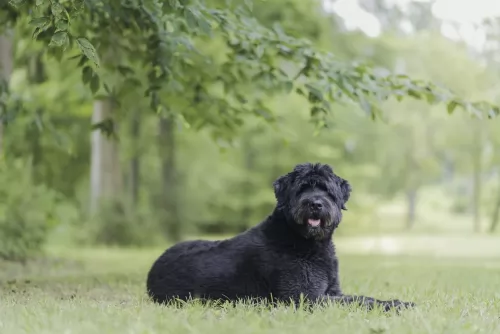 These large dogs have descended from Flemish cattle dogs, and in French, the word Bouvier means herdsman or cattle herder. This is because the dog was used for driving cattle. The Bouvier comes from the Flemish region of Belgium where it was bred as a working farm dog. It is believed that the breed may have come from crossing local farm dogs with imported Irish Wolfhounds, Schnauzers, Tibetan Mastiffs, Brabanters, Griffons and Beaucerons.
These large dogs have descended from Flemish cattle dogs, and in French, the word Bouvier means herdsman or cattle herder. This is because the dog was used for driving cattle. The Bouvier comes from the Flemish region of Belgium where it was bred as a working farm dog. It is believed that the breed may have come from crossing local farm dogs with imported Irish Wolfhounds, Schnauzers, Tibetan Mastiffs, Brabanters, Griffons and Beaucerons.
It was in 1910 that the first Bouviers appeared at the international dog show in Brussels, with a standard for the breed being adopted in 1912.The American Kennel Club recognized the dog in 1929. It was after World War 11 that Bouviers were brought to America and the American Bouvier des Flandres Club was founded in 1963.
With the Mastiff breeds, the rarest and the smallest is the Nebolish Mastiff. Bred to be more agile than the giant mastiffs, the Nebolish was developed in Canada. They were developed by crossing several breeds, such as the English Mastiff, Neapolitan Mastiff, Dogue de Bordeux, Bull Terrier, Bullmastiff, Boxer, St. Bernard, and Deutsche Dogge. Perhaps there was some Great Dane as well. It was also hoped that they would have better health than the rest of the Mastiff breeds.
There are also those who believe the Nebolish Mastiff is not a Canadian crossbreed but rather the re-creation of the giant dogs that lived with the soldiers of Alexander the Great. Still others believe the breed is still being developed and no standard is yet true. They believe the dog is a hybrid. No one knows the exact breeding lines today and not many are breeding the Nebolish today. Thus, the dog is extremely rare.
Only the American Breeder Association (ABA), the Canada Molosser Association (CMA) and the Dog Registry of America Inc. (DRA) recognize the Nebolish Mastiff as a separate breed.
These dogs are courageous, loyal and dignified like all Mastiffs. They are protective of their families or their flocks. They are loving, intelligent and even-tempered. They are known to be great with kids since they are patient and calm – easy to train.
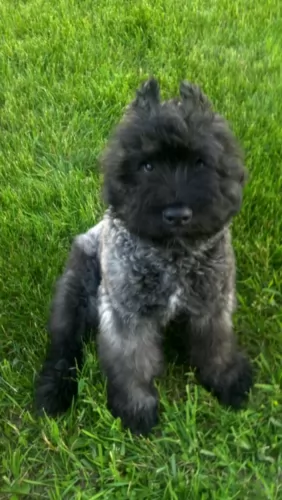 The Bouvier is a large compact, well built dog with strong muscled limbs. He stands at roughly 59 to 70 cm high at the withers, weighing between 27 and 52 kg. He has a large head with a thick and abundant coat which is of rough appearance. The coat is mostly black, but you’ll also find a range of other shades such as brindle, grey and fawn.
The Bouvier is a large compact, well built dog with strong muscled limbs. He stands at roughly 59 to 70 cm high at the withers, weighing between 27 and 52 kg. He has a large head with a thick and abundant coat which is of rough appearance. The coat is mostly black, but you’ll also find a range of other shades such as brindle, grey and fawn.
The back of the dog is level and broad, and is typically wider in female dogs. The back legs are strong and muscular. Some Bouvier des Flandres are born tail-less and this is most attractive. Most Bouvier dog owners used to have the tails docked because of the excellent appearance, but with docking now being banned, the tail is kept long. The muzzle is wide, the nose large, the eyes dark brown and the ears high set and floppy.
The Bouvier is intelligent, energetic and full of confidence while being calm and balanced in temperament. The puppies are vocal and full of antics, but as the Bouvier grows into adulthood, he mellows and becomes a steady family friend who gets on well with each human family member. He loves spending time with his family and becomes both friend and guardian, making a good watchdog too.
The Nebolish Mastiff is very much like all other mastiffs with the exception of height and weight. He has a large head, long legs, strong neck, oval shaped paws, wide chest and large bones. He has solid muscles, large ears and a wide snout. They usually weigh anywhere between 43 and 82 kg. They tend not to slobber like the other mastiff breeds as a result of their breeding. They have a black mask and tail may or may not be docked.
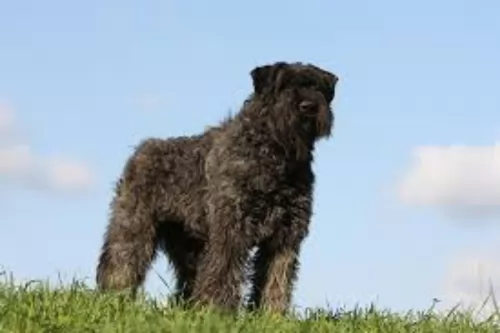 The Bouvier is such an amicable dog and strong and energetic too. He makes the most marvellous companion and will happily adapt to life in the city or in the country, although, with his big size, he is better suited to a home where there is enough space to run around in.
The Bouvier is such an amicable dog and strong and energetic too. He makes the most marvellous companion and will happily adapt to life in the city or in the country, although, with his big size, he is better suited to a home where there is enough space to run around in.
He is loyal, loving and protective and when you make sure to make him an active part of your family, you’ll find in him all the characteristics of a true friend.
Yes, they are very good with children.
Agility and swimming
No – they don’t do well with apartments and small spaces. They need a large fenced in yard.
High but can be stubborn
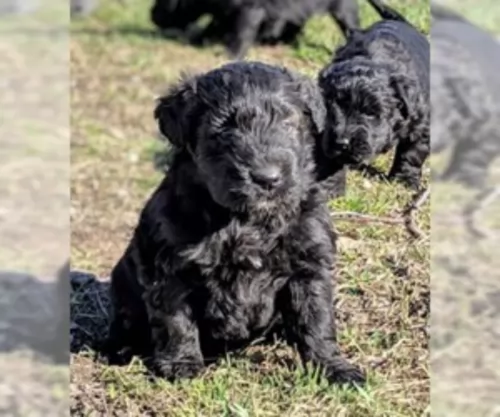 The big teddy-bear of a dog is a healthy breed, but as a large dog, you will need to look out for certain health problems with him.
The big teddy-bear of a dog is a healthy breed, but as a large dog, you will need to look out for certain health problems with him.
Xrays have been done on many Bouvier des Flandres by the Club and by the Orthopedic Foundation of America and it has been found that a significant percentage of Bouviers were dysplastic. Hip dysplasia is a deformity of the hip joint and many large breed dogs battle with this. It can be very sad for dog lovers as they watch their dog battling to get up after lying down and sometimes lameness in the hind legs.
Dental disease is a common problem in many dogs, and the Bouvier isn’t excluded one bit. If you don’t brush your pet’s teeth with special dog toothpaste and toothbrush, there is tartar build-up which can lead to bad breath and gum infection. Dental disease can lead to pain in the teeth and even the loss of teeth. Bad teeth affect the entire body, and the heart, kidneys and joints can all be negatively affected.
The Bouvier is a large dog prone to obesity. This is a serious disease that can lead to all kinds of digestive disorders, back pain as well as heart disease. It can be easy just to give in to your pet’s pleading eyes, but in the long run, excessive weight can spell a host of health problems.
Bred to be much healthier than other mastiff breeds, the Nebolish has very few health concerns. They live twice as long as most other Mastiff and giant breeds at up to 14 years. The most often reported health issue is:
bloat – where the intestines and stomach organs are twisted or distended. Bloat can be deadly so don’t hesitate on treatment. Avoid it by not overfeeding after or before exercise.
Test for Hip dysplasia as it can cause lameness or arthritis.
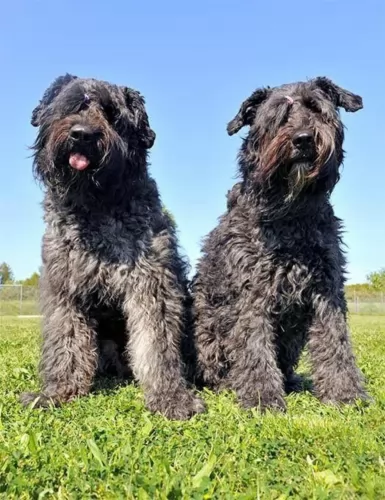 Your Bouvier is an intelligent, independent dog and you will be doing him a favor by having him socialized and trained. He becomes such a pleasure to have around, being obedient and willing to respond to your commands.
Your Bouvier is an intelligent, independent dog and you will be doing him a favor by having him socialized and trained. He becomes such a pleasure to have around, being obedient and willing to respond to your commands.
Every dog, and particularly large dogs like the Bouvier, should be able to rely on a daily walk, a run in the park or on the farm and have special games from his owner. Not only does participating in activities together build a strong bond between dog and owner, its important to avoid boredom and frustration with your dog. You bought him so you therefore have a responsibility toward him.
Your Bouvier des Flandres has a thick, medium-length coat that gets a shaggy look to it. The breed needs regular brushing every second day or so to get rid of loose hairs and to prevent the hair matting. He will require some professional grooming to look and feel his best. With his thick coat, he is hypoallergenic which can be a relief for allergy sufferers.
The Bouvier has to be on high-quality dog food, whether you give him home-made food or commercially manufactured food. It has to have the right amount of vitamins and minerals. If you’re unsure about feeding a dog, remember that the amount and type of food you give your pet must be appropriate to your dog’s age, size and energy levels.It can also be wise to know which human foods are bad. Speak to your vet about your dog – they are a minefield of useful information about your pet. Fresh, cool water should be be available at all times.
Don’t overfeed and don’t feed too much protein in the first year. Feed 1-2 cups in two meals.
bloat – Tendency to become obese so don’t over feed. About 2-3 cups in 2 meals per day.
agility and flexibility
This intelligent breed actually enjoys training, toys and all kinds of mentally stimulating puzzles. They love water and are very good swimmers. They need an average amount of exercise - a couple walks per day. Need a large fenced yard. They make great therapy dogs and play catch.